QML 102 - Deeper Classifiers
Contents
QML 102 - Deeper Classifiers¶
In the last tutorial we saw the most basic ideas of quantum machine learning algorithms. They included:
division in training and test data
simple training
accuracy tests.
However, all of this happened in an extremely simple case, which allowed us to work with simple algorithms. In this tutorial, we will discuss the possibility to learn more complicated structures with deeper circuits. As in the last tutorial, the task will be once again the classification of data points \(x_i\) with labels \(y_i\). However the structure will be more complicated, such that the previous circuits would fail. So in this tutorial we will learn:
deeper reuploading circuits
training with optimizers.
All circuits will be implemented with
qiskitbecause of its wide ranging use.
We will always focus on simplicity throughout this tutorial and leave the more complex discussions to the extensive literature and later tutorials.
# only necessary on colab to have all the required packages installed
!pip install qiskit
!pip install pylatexenc
The learning task¶
As previously, we will focus on a problem with one dimensional input data, which we associate with a label {0, 1}. However, the data set has a strucute, which will require deeper circuits.
from typing import Union, List
import numpy as np
import matplotlib.pyplot as plt
from tqdm import tqdm
# for splitting the data set
from sklearn.model_selection import train_test_split
# for the quantum circuits
from qiskit.circuit import QuantumCircuit, Parameter
from qiskit import Aer
np.random.seed(1)
x = np.random.uniform(-np.pi, np.pi, 100)
y = 1.0 * (abs(x) > 1.4*np.pi/2)
f, ax = plt.subplots()
ax.plot(x, y, "o")
ax.set_xlabel("input value")
ax.set_ylabel("label")
Text(0, 0.5, 'label')
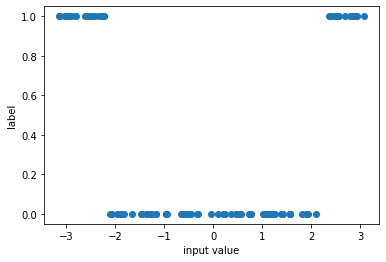
Once again we split the data set and get into the training.
x_train, x_test, y_train, y_test = train_test_split(
x, y, test_size=0.20, random_state=42
)
f, (ax1, ax2) = plt.subplots(1, 2, figsize=(15, 5), sharex=True, sharey=True)
ax1.plot(x_train, y_train, "o")
ax1.set_xlabel("input value")
ax1.set_ylabel(" given labels")
ax1.set_title("training data")
ax2.plot(x_test, y_test, "o")
ax2.set_xlabel("input value")
ax2.set_title("test data")
Text(0.5, 1.0, 'test data')
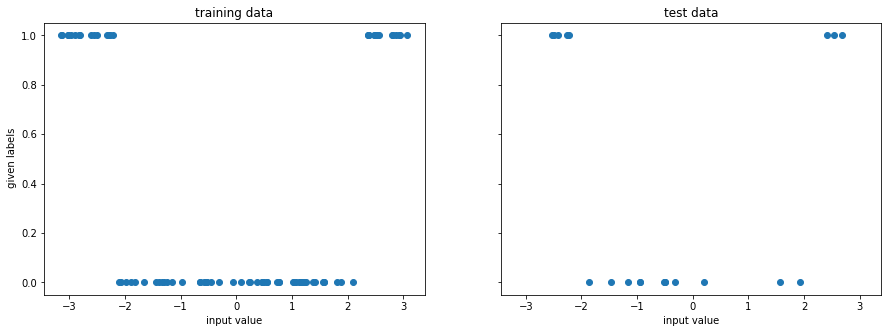
A deeper algorithm¶
To achieve training for this more complex data set we have to work with a data-reuploading approach. It is similiar to our previous approach as it does the following.
Prepare the initial state.
Apply a parametrized circuit with parameters \(\mathbf{w}\) that depend on the input \(U(\mathbf{w}, x_i)\).
Read out the label from the measurement of the qubit.
However, the circuit has now a structure, where input parameter is is applied again and again, interleaved with some processing layer. This allows for non-trivial classification tasks, which was analyzed in great detail here.
sim = Aer.get_backend("aer_simulator")
theta = Parameter(r"$\theta$")
alpha1 = Parameter(r"$\alpha_1$")
qc = QuantumCircuit(1)
qc.rx(theta, 0)
qc.rz(alpha1, 0)
qc.rx(theta, 0)
qc.measure_all()
qc.draw("mpl")
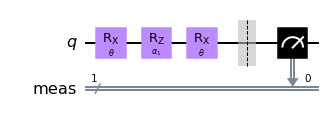
We can now look at the performance of the code with some randomly initialized weight in predicting the appropiate label.
def get_accuracy(
qc: QuantumCircuit, alpha: float, weight: float,
xvals: List[float], yvals: List[int]
) -> Union[float, List[int]]:
"""
Calculates the accuracy of the circuit for a given set of data.
Args:
qc: the quantum circuit
alphas: the training parameter
weights: the weights for the inputs
xvals: the input values
yvals: the labels
Returns:
The accuracy and the predicted labels.
"""
pred_labels = np.zeros(len(xvals))
accurate_prediction = 0
for ii, xinput, yinput in zip(range(len(xvals)), xvals, yvals.astype(int)):
# set the circuit parameter
circuit = qc.assign_parameters(
{theta: weight*xinput,
alpha1: alpha,
},
inplace=False,
)
# run the job and obtain the counts
Nshots = 4000
job = sim.run(circuit, shots=Nshots)
counts1 = job.result().get_counts()
# obtain the predicted label on average
if "0" in counts1:
pred_label = 1 * (counts1["0"] < Nshots/2)
else:
pred_label = 1
pred_labels[ii] = pred_label
if yinput == pred_label:
accurate_prediction += 1
return accurate_prediction / len(yvals), pred_labels
weight = 1
alpha = np.pi/4
accuracy, y_pred = get_accuracy(qc, alpha=alpha, weight=weight, xvals=x_train, yvals=y_train)
false_label = abs(y_pred - y_train) > 0
x_false = x_train[false_label]
y_false = y_pred[false_label]
print(f"The circuit has an accuracy of {accuracy}")
f, ax = plt.subplots()
ax.plot(x_train, y_pred, "o", label="predicted label")
ax.plot(x_false, y_false, "ro", label="false label")
ax.legend()
The circuit has an accuracy of 0.275
<matplotlib.legend.Legend at 0x7f1f9a216a10>
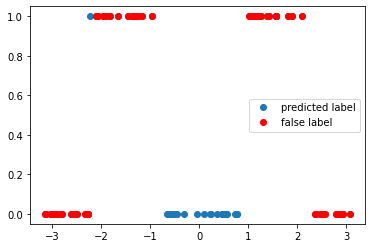
Training¶
We once again have to train the circuit. However, this time it does not have a single training variable, but four. We therefore have to fall back to scipy.optimize package to optimize the target function.
from scipy.optimize import minimize
def get_cost_for_circ(xvals, yvals, machine=sim):
"""
Runs parametrized circuit
Args:
x: position of the dot
y: its state label
params: parameters of the circuit
"""
def execute_circ(params_flat):
weight = params_flat[0]
alpha = params_flat[1]
accuracy, y_pred = get_accuracy(qc, alpha=alpha, weight=weight, xvals=xvals, yvals=yvals)
print(f"accuracy = {accuracy}")
return 1-accuracy
return execute_circ
total_cost = get_cost_for_circ(x_train, y_train, sim)
# initial parameters which are randomly initialized
np.random.seed(123)
params = np.random.uniform(size=2)
params_flat = params.flatten()
# minimze with COBYLA optimize, which often performs quite well
res = minimize(total_cost, params_flat, method="COBYLA")
accuracy = 0.675
accuracy = 0.6
accuracy = 0.775
accuracy = 0.65
accuracy = 0.4
accuracy = 0.9
accuracy = 0.65
accuracy = 0.65
accuracy = 0.825
accuracy = 0.825
accuracy = 1.0
accuracy = 0.925
accuracy = 0.9625
accuracy = 1.0
accuracy = 0.9625
accuracy = 0.975
accuracy = 1.0
accuracy = 1.0
accuracy = 1.0
accuracy = 1.0
accuracy = 1.0
accuracy = 1.0
We can see that the accuracy is converging throughout the training quite nicely and it is now time to look into the optimal training parameters.
opt_weight, opt_alpha = res.x
print(f"optimal weight = {opt_weight}")
print(f"optimal alpha = {opt_alpha}")
optimal weight = 0.5093757145525236
optimal alpha = 1.3032510317367447
We can now test the accuracy on the optimal value of the weights again to test the accuracy.
accuracy, y_pred = get_accuracy(qc, weight=opt_weight, alpha = opt_alpha, xvals=x_train, yvals=y_train)
false_label = abs(y_pred - y_train) > 0
x_false = x_train[false_label]
y_false = y_pred[false_label]
f, ax = plt.subplots()
ax.plot(x_train, y_pred, "o", label="predicted label")
ax.plot(x_false, y_false, "ro", label="false label")
ax.legend()
print(f"The trained circuit has an accuracy of {accuracy:.2}")
The trained circuit has an accuracy of 1.0
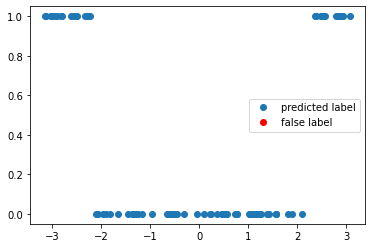
Test¶
Having finished the training, we can test the circuit now on data points that it has never seen.
test_accuracy, y_test_pred = get_accuracy(
qc, weight=opt_weight, alpha = opt_alpha, xvals=x_test, yvals=y_test
)
false_label = abs(y_test_pred - y_test) > 0
x_false = x_test[false_label]
y_false = y_test_pred[false_label]
print(f"The circuit has a test accuracy of {test_accuracy:.2}")
f, ax = plt.subplots()
ax.plot(x_test, y_test_pred, "o", label="predicted label")
ax.plot(x_false, y_false, "ro", label="false label")
ax.legend()
The circuit has a test accuracy of 1.0
<matplotlib.legend.Legend at 0x7f1f99613150>
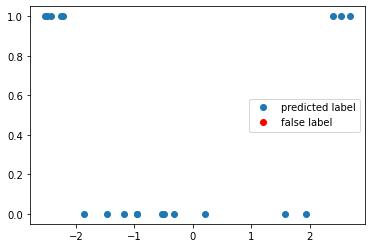
Summary and outlook¶
In this tutorial, we have seen that the extension of the circuit to deeper structures allows us to learn training sets, which were previously impossible to evaluate. In the next tutorials, we will extend these circuits in two directions:
Work with larger dimensions of input parameters. This is what we would like to do quantum machine learning anyways and where the main innovation of the data reuploading circuits lies.
Work on circuits with multiple qubits to classify different classes and introduce entanglement in a systematic fashion.